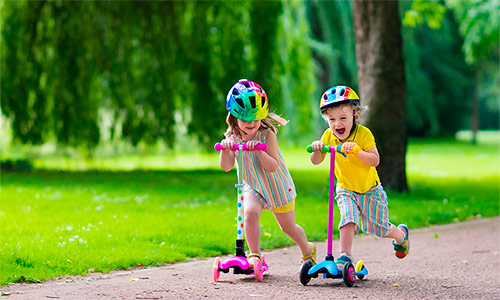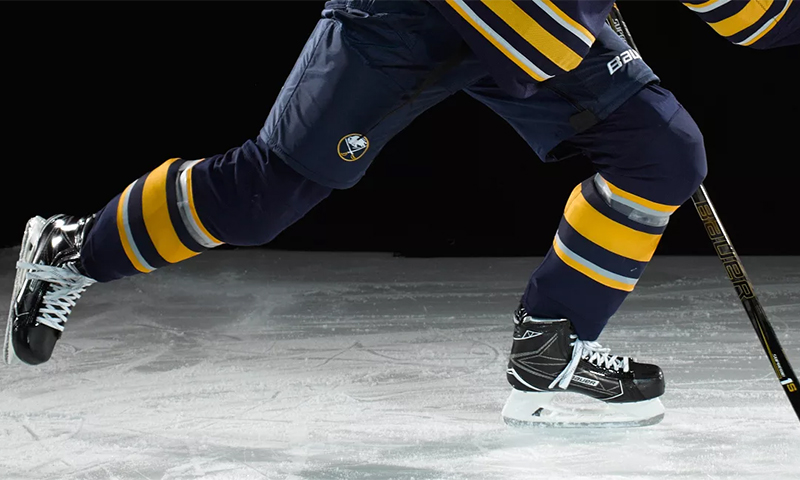Skateboarding is very popular today, but it was “long boards” - the longboards provided the sport with the love of young people. They can accelerate to crazy speeds, show the most spectacular stunts and experience unrealistically cool feelings. Here the main thing is to choose the right board, deciding what is more important for you - speed or maneuverability. It becomes clear to any experienced rider at first glance what this or that board is capable of, and our advice will help everyone else to understand the nuances of choice.
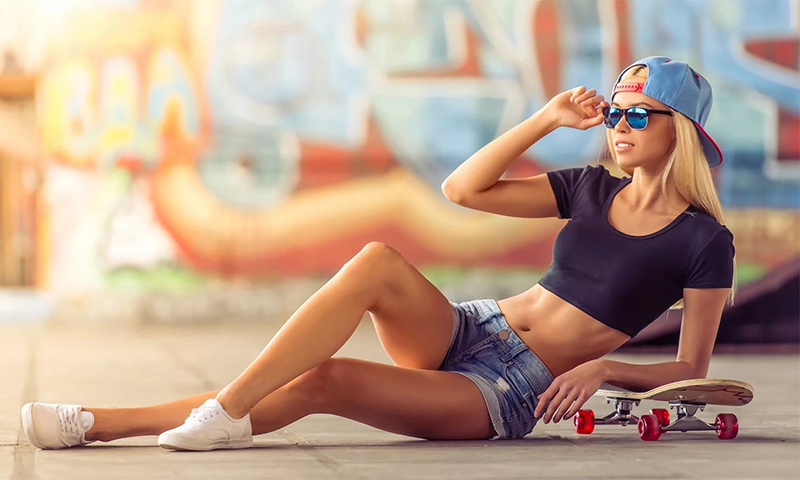
Content:
The best manufacturers of longboards - which company to choose
If you are looking for a longboard as a gift to a friend, and you don’t have the desire to study the features of the shells in detail, simply choose a model from a well-known company. No need to delve into the nuances of the design and deal with the quality of materials - a long life and good driving characteristics of the board will provide the manufacturer.
The best companies that produce such longboards are:
- Rayne;
- Yocaher Products;
- Madrid;
- Beetle;
- Oxelo;
- Sector.
The cool models of “dlinnoskeitov” of these manufacturers are presented in our ranking. You can simply choose one of them or set a goal and find your ideal board by following the tips below.
The principle of operation and the device longboard
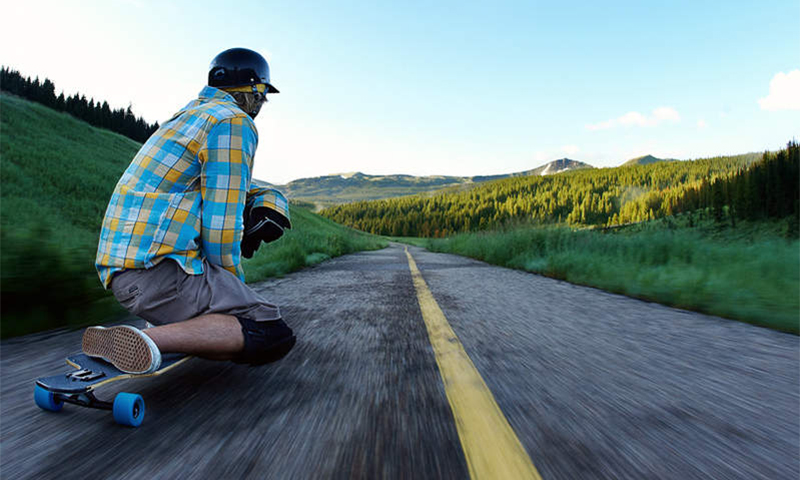
Longboard is one of the types of skate, respectively, it is assembled from the same components:
1. Deca - it is longer than on a skateboard, and this is the main difference between Long;
2. Trucks or pendants attached to the board through special damping pads;
3. Wheels with high-precision bearings.
The principle of skating on a long board is not too different from ordinary skateboarding either. But due to the big deck, the longer keeps on the track more confidently and provides a more comfortable ride - no wonder many use it as a vehicle.
Types of longboards
For cruising and carving

Among the longboards, this is one of the most comfortable and stable models. Decks here are medium hard, have the shape of an elongated oval, and their length can be from 70 to 130 cm.
Wheels are often set soft, with a diameter of 76 mm, which allows you to easily overcome the small asphalt irregularities. They, in turn, are equipped with ABEC 7 bearings - reliable and knurled, helping to develop high speeds.
Models about 70 cm are more suitable for fans of feints and carving, and long and wide boards will perfectly cope with the role of cruisers.
Pros:
- Sufficiently maneuverable for its size;
- Suitable for bridging long distances;
- You can reach speeds of up to 100 km / h;
- On short models it is good to perform various feints and tricks;
- Wide and soft wheels not bad swallow asphalt unevenness.
Minuses:
- Pretty overall;
- There are difficulties with performing a number of tricks, since even the shortest model exceeds the size of a standard skate.
Slalom models
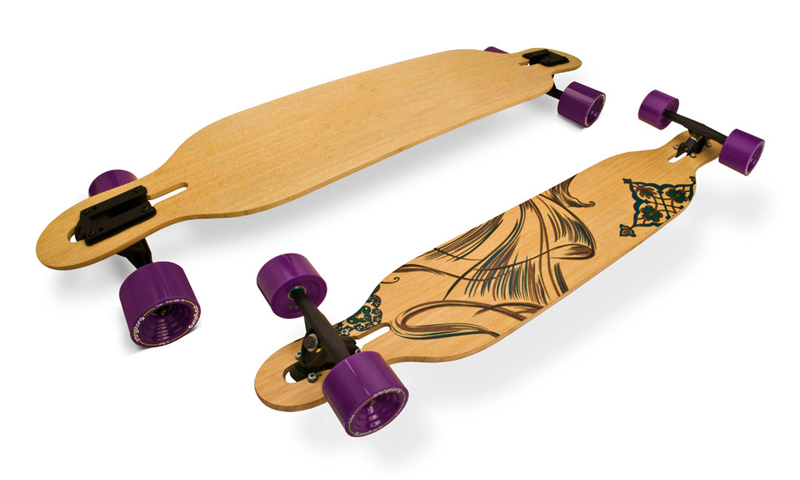
These longboards are designed to perform feints and maneuvering. The length of the deck here does not exceed 60-70 cm, but the nose is noticeably narrowed.
On the boards for slalom put wheels of small or medium hardness, with a diameter of 69-72 mm. As a rule, they come with straight edges, so as not to let the board in a long drift. The tracks are narrow - thanks to this deck does not catch them on sharp turns.
As for the bearings, in the slalom-models are often used fives and sevens.
Pros:
- Excellent maneuverability;
- Ability to perform tricks;
- Develop a fairly high speed;
- You can overclock the board without pushing with your foot, that is, pampit.
Minuses:
- Not designed for long descents;
- Less resistant than other longboard models.
Downhill model
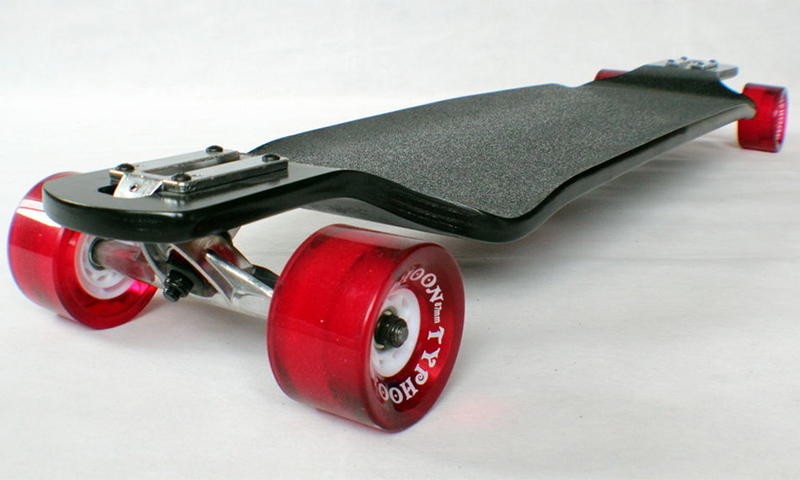
Distinctive features of such longboards are long and rigid deck (about 1 m) and strong tracks. The board is designed for speedy descents, so its design should exclude the board's “wagging”: have a good thickness of 9-11 layers of wood and a hard concave.
The wheels here are 70-75 mm in diameter, the tracks in width correspond to the dimensions of the deck, and for reliability they are screwed to it with bolts that pierce the board through.
Pros:
- Allow to accelerate to 140 km / h;
- Stable on the track;
- Durable and reliable;
- Always equipped with good ABEC 7 bearings.
Minuses:
- Due to the low maneuverability, it is difficult to make turns;
- Not suitable for tricks.
Sliding Models
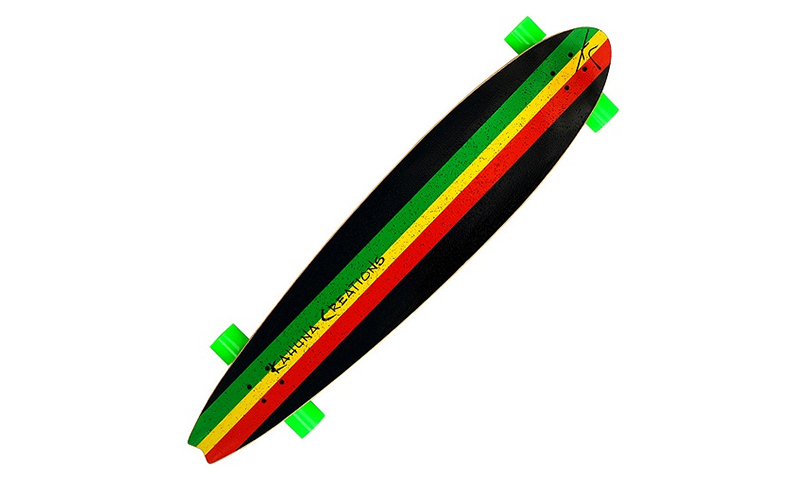
These longboard models are designed for a discipline that remotely resembles downhill, only with an abundance of technical turns and slides - slides (hence the name). The length of such boards starts from 90 cm, the decks themselves are stiff and rather large, reaching up to 1.3 cm.
The wheels of the sliders are small and solid, with ABEC-7 mandatory bearings, the tracks are the same size as the board. Such longs have a symmetrical shape so that during the downhill there is an opportunity to “drift” in any direction and make turns in motion.
Pros:
- Easily gaining speed up to 100 km / h;
- You can put the board in a controlled drift;
- Enough safe and resistant;
- They are characterized by good maneuverability;
- Tough and durable.
Minuses:
- Take up a lot of storage space;
- Narrow "specialization" of boards.
Surf-style

These longboards can not be confused with anything, since in length they reach 1.5-3 meters and are addressed to fans of surfing. On such boards during the skating, you can walk, sit, lie down or sit in a pair. The deck here is always very tough, up to 2 cm thick, the diameter of the wheels reaches 100-120 mm. The tracks must also be durable, reliable and match the size of the board.
Pros:
- Unrealistically stable and reliable;
- It is convenient to ride together (though you will have to stand in the area of the tracks);
- While riding you can move along the board, sit and even lie down;
- Perfect for long hauls.
Minuses:
- Huge size and weight;
- Minimum maneuverability;
- Require good roads.
Dancing models
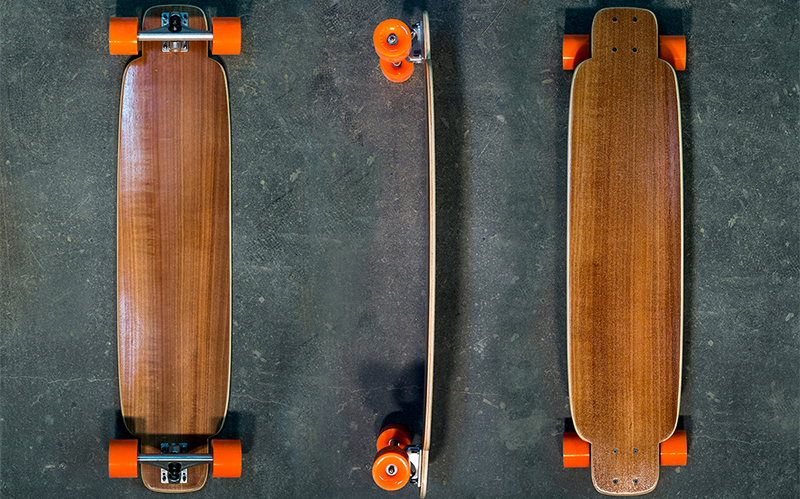
These boards are designed to perform various dance tricks, for which they are equipped with pronounced tails. The length of the deck ranges from 80 to 150 cm, the width is about 8-10 cm. The board is quite elastic and thin (no more than 1 cm), because of which, when rolling, it sags slightly in the middle. Trucks are already a bit of a board, which allows us to get a good maneuverability of the projectile.
The wheels are set to medium diameter (70-75 mm) with minimal stiffness. And since high speed in dancing is not important, there is an opportunity to save on bearings - a three or five is enough for a “dancing” longboard.
Pros:
- A variety of tricks that can be performed on such a board;
- Good stability;
- Excellent maneuverability (adjusted for the length of the deck), and the board itself listens well to the host;
- Spectacular appearance.
Minuses:
- There are problems with transportation;
- Short-lived.
Mini-cruisers (plastbordy)
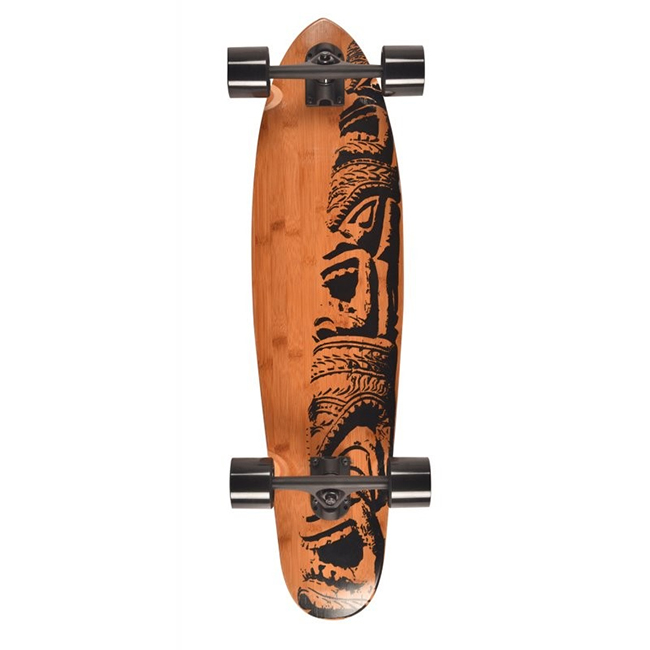
Strictly speaking, these crumbs with a 57 cm long deck are not - they are more likely their younger brothers. But urban young people loved the bright model of the fish, because they really can go around the city for hours, and if necessary, easily put into a bag or fasten to a backpack.
On the other hand, the surge in popularity of boards with a plastic deck made manufacturers seriously expand the size range of mini-cruisers. Now their length can reach up to 115 cm, which automatically translates plastboards into the category of longs.
These models always come with a curved “tail”, a wide removal of tracks and small (up to 70 mm) wheels of medium-hard PU, which makes skiing quite comfortable, even on bad asphalt.
Pros:
- Lightweight and easy to carry;
- Wheels and plastic deck well absorb vibrations and “swallow” road bumps;
- Bright, recognizable design;
- Suitable for both cruising and simple tricks;
- Good maneuverability;
- Relatively affordable price.
Minuses:
- Classic mini-cruisers (22 ″) are not stable enough;
- Plastboards have their own rider weight limitations.
Longboard selection options
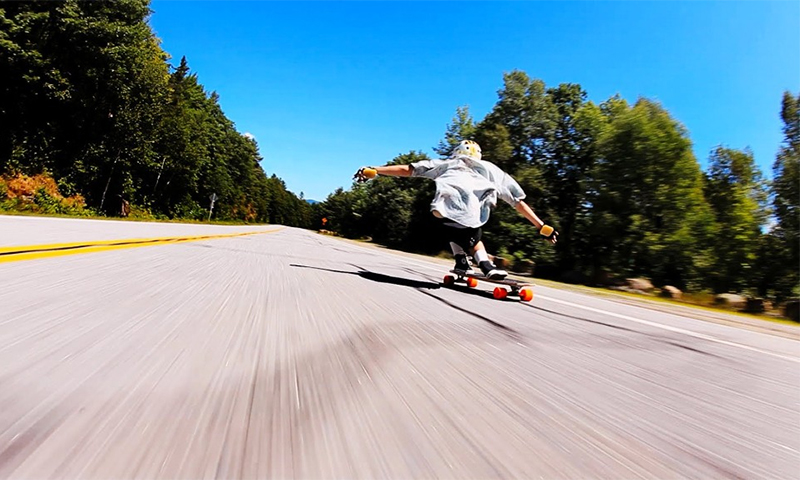
Deck length
Its maneuverability depends on the size of the board: the longer the board, the more difficult it will be to manage and go around obstacles. Look for the best option, taking into account the features of the tracks on which you plan to roll.
The following numbers will help you to find your way:
1. For tricks it is better to choose boards up to 80 cm long (with the exception of dancing boards with their elongated nose and tail).
2. For high-speed descents fit models up to 120 cm.
3. The ideal option for long journeys is a board from 1 to 1.5 m.
Deck material
Classic decks are made of 5-13 layers of laminated wood. And the smaller the number of “cake layers”, the more resilient and responsive the board will be, although its service life will decrease. Increasing the number of layers will make the longboard tougher, harder and more reliable, will have a positive effect on the speed characteristics of the projectile, but it will be more difficult to do tricks in this case.
Popular materials that go for gluing boards:
1. Canadian maple - the most expensive and durable.
2. The Chinese maple is quite a bit inferior to the Canadian in terms of quality, but costs almost half the price.
3. Bamboo is quite elastic and is well suited for the manufacture of maneuverable longboards, but is rarely available for sale.
4. Plastic - if it is an expensive and high-quality material, it will fully withstand serious loads and at the same time please with high elasticity. But from cheap plastic nothing good can be expected - it is unlikely that it will last more than 1-2 seasons.
A longboard deck can be combined and made from different materials. Most often they produce boards, where the Canadian maple is transferred by the Chinese - they have rather high characteristics, and at the same time it is more affordable than purebred Canadas for the price.
There are other, cheaper options, for example, with birch veneer - these decks are unlikely to withstand the heavy rider and are definitely not suitable for serious stunts.
Bearings
On the longboards, 2 bearings of the 608th model are installed in each wheel, which are abbreviated as ABEC. The number next to the letter indicates the accuracy class of the bearing - it will determine the speed characteristics of the selected projectile.
1. ABEC 3 - the slowest, cheapest and short-lived bearings that are installed on the budget longboards. They do not allow developing and maintaining a high speed for a long time - their limit is 20-30 km / h.
2. ABEC 5 - more popular because they can accelerate to 60-70 km / h. These bearings are considered the best in terms of price and quality.
3. ABEC 7 - professional racing bearings: durable, reliable and high-speed, but they are expensive.
4. ABES 9 and ABES 11 are the most accurate and speedy, but the price for them is exorbitant, and the service life is small. Precision units are not designed for heavy loads.
Suspension
Longboard suspension is represented by tracks - metal T-shaped parts 150 or 180 mm long, located under the board. The angle of rotation of the tracks depends on the model of the skate. The standard is considered to be 50 °, for long decks it is better to reduce this indicator to 44 °, for short ones an increased angle of rotation is allowed (about 60 °).
You should also pay attention to the material of the suspension:
1. Aluminum - the best option, lightweight and moderately durable.
2. Steel costs a little less, but increases the weight of the longboard, without giving any special advantages in return.
3. Composite and plastic - these materials are only suitable for children who are not experiencing high loads.
Wheel dimensions and stiffness
Wheels in longbord choose on two main indicators: size and rigidity.Their diameter can be from 40 to 150 mm, but 70 mm is considered a standard.
1. Small wheels have good maneuverability and allow you to accelerate faster, but you should not expect record speed from them.
2. Large ones, on the contrary, are harder to “crush”, but then the longboard will fly an arrow.
Please note: wheelsets in some longboards come in different sizes. Most often you can find boards with wide and large rear wheels and reduced front. This approach provides the skate at the same time good speed characteristics and excellent maneuverability.
Not the last role is played by the rigidity of the wheels - the board's behavior on different types of coating depends on it:
1. 75A-87A - the softest wheels designed for comfortable cruising. They do well to extinguish shocks and vibrations, provide excellent grip, but will not give you greater speed.
2. 88A-95A - wheels of medium hardness, fast and durable. However, on uneven asphalt, they will transmit all shocks and vibrations to their feet, which is not very pleasant.
3. 96A and above are the toughest wheels that are suitable for sliding and speedy runs, but have very weak grip. On these ride only experienced riders and those who train on concrete.
Which longboard to choose

1. Those who are going to use a longboard as a personal vehicle will be suitable cruise models: mini-plastboards for pokatushek around the city or wide full-size boards up to 130 cm long for many kilometers of spans on the highway. Bearings in both cases, it is worth taking ABEC 7, but in the urban modelka, the "five" will show itself well. As for the wheels, it is better to stick to the average indicators of diameter and rigidity.
2. If you want to perform tricks on a longboard, then the best model for you will be dancing with a long Canadian maple deck, wide soft wheels, ABEC 3 or 5 bearings. Shortened slalom boards with their excellent maneuverability will also do.
3. You can buy a slalom board and for ordinary riding around the city or on skate courts. These are generally universal boards that accelerate well and at the same time allow you to do various tricks. Bearings must be of type ABEC 5 or ABEC 7, the wheels can be chosen to suit your taste, as long as they are wide.
4. Love downhill? Take a meter downhill or slider board with wide but stiff wheels with a diameter of 70-75 mm (it is still better for beginners to practice on soft polyurethane). ABES 7 bearings only. Pay special attention to the quality of the deck - it must be made entirely of Canadian maple and have at least 9 layers.
5. Fans of water surfing will experience a separation from the sea in the city with a super-long longboard with large and soft wheels, ABEC 5 bearings. But here you will need a fairly solid deck, since the points of support are separated far from each other, so do not skimp on the Canadian maple or at least gluing it together with Chinese.
How much is a longboard

1. Good carving can be purchased for 5000-10000 rubles. Approximately the same prices are set on the slalom model, only their entrance threshold is slightly higher - from 7,000.
2. Slightly more expensive boards will cost downhill - from 8,000 to 11,000 rubles.
3. The "dance" and slide longboards have a rather large price run - such models can be bought for 5-6 or 13 thousand rubles.
4. Surfboards on wheels are still rare for us, but if you search well, you can buy yourself such a length for 10-20 thousand rubles.
5. An adult plastboard will cost from 600 to 14 thousand rubles, although it is better to reject frankly cheap boards.
It will be interesting to friends too

